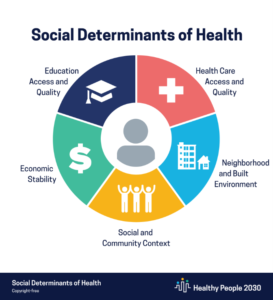
In short, no. Social Determinants of Health (SDOH) can sound high level, but in reality it includes the most basic of human necessities. Whether patients can and will succeed in treatments depends on a multitude of factors of which SDOH plays a significantly impactful role.

Put plainly, these are the factors that impact health. The primary SDOH factors are (DHHS Reference):
Education Access and Quality
This factor supports a patient’s ability to understand the conversations they have with their provider, the process of using their insurance, how to follow their treatment/medication instructions, and more. Patients with minimal access to education or decent quality education may need more support in understanding basic practice workflows, financial responsibilities, appropriate levels of care, and ways to avoid exacerbations.
Economic Stability
Patients with financial stress often see that stress as more important that physical health. Meaning they will avoid doctors’ appointments that may have copayments or coinsurance responsibilities or they may skip purchasing essential medications. In addition, this can make patients defensive or cause them to avoid appropriate levels of care.
Health Care Access & Quality
Shortages of health care providers are a national concern and fact for many patients. During the public health emergency (PHE), there have been significant flexibilities for telehealth visits and temporarily granted interstate provider privileges. Once the PHE ends, many of these flexibilities will expire, leaving patients again in a precarious position to access care.
Social and Community Context
Community resources, social engagement, and loneliness can all affect a patient’s ability to succeed significantly. These factors are especially important for behavioral and mental health success, which lean on coordinated care for greater efficacy.
Neighborhood & Environment
Having a safe place to live and play is also a factor for success. If patients have an environment in which they can be active, safely go outside to play or exercise, or at the very least a roof over their head, they are in a much better position for success than the alternative. In addition, patients in abusive households, or environments that welcome drug and alcohol use, they may be more prone to make risky life decisions.
How To Incorporate?
Incorporating SDOH assessments in your organization can help to identify where patients may need additional support in order to succeed. Include these factors in treatment plan considerations and into the regular workflow of the organization.
Surveying patients is an essential process in any facility. Often, we focus purely on patient satisfaction surveys. Though these are a good indicator of patient perception, they do not grant insight into the challenges that a patient may have at a basic human level.
Whether surveys are electronic, on paper, through the patient portal, or sent via text message, gathering this information can support the clinical process in ways that directly and positively impact patient outcomes.
For more information, look at the resources provided by DHHS at https://health.gov/healthypeople/priority-areas/social-determinants-health/literature-summaries
References
Healthy People 2030, U.S. Department of Health and Human Services, Office of Disease Prevention and Health Promotion. Retrieved 8/11/22, from https://health.gov/healthypeople/objectives-and-data/social-determinants-health
Taya Moheister, EMBA, CMPE, CMOM
LinkedIn: https://www.linkedin.com/in/tayamoheiser/
Twitter: https://twitter.com/tayamoheiser

